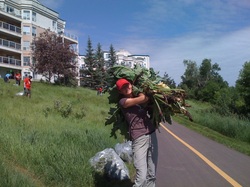
Burdock is a biennial with a very long taproot. In the first year, it produces a rosette of leaves, but does not flower. In the second year, it grows much taller and produces a strong stalk with flowers that turn into very prickly heads or burrs. These seed heads catch on clothes and get caught in the fur of pets, helping to disperse the plant to new locations. This can be rather annoying and even painful, as the hooks are very sharp.
Burdock has spread widely in the river valley, in back alleys and yards in Edmonton. It is a very successful plant but also considered a noxious weed. Homeowners are required to prevent the spread of it by cutting it before it goes to seed or by removing it.
Burdock is not all bad; the roots and young shoots are edible and the plant has been used for medicinal purposes. Samuel Thayer describes how to identify, harvest and use burdock in his book called “The Forager’s Harvest”.
Burdock is also considered to be a “dynamic nutrient accumulator”, a plant that draws specific nutrients from deep in the soil and concentrates them in the leaves. When the leaves are chopped and left on the soil to decompose or added to the compost, the nutrients become available to other plants. Burdock is said to accumulate manganese (Mn), a micronutrient that plants need for healthy growth. Personally, I would not cultivate this plant, but when required to deal with it, I would certainly use the leaves in moderation and dispose of any stalks with flowers or seeds.
While digging up the patch of burdock in the Mill Creek Ravine, I decided to try and rescue some of the roots and take them home for cooking. The challenge with burdock is that the roots are usually in hard clay, requiring a very strong spade and a fair amount of muscle power. I managed to pull up some of the roots, but most broke off and the best part was left in the hard soil. Still, I had a few roots that I boiled, then added to a stir-fry with other vegetables. In my opinion, burdock has a nice flavor. If you need to dig this potential monster out of your yard, why not use some roots or peel young shoots in early summer for an unusual addition to the menu!
*Evergreen and Molson partnered up for 100 stewardship events across the country, for the Molson Canadian Red Leaf Project, http://on.fb.me/mcRedLeaf. Community members in major cities have been invited to volunteer their time planting trees, pulling invasive plants or cleaning up garbage. In return, they get a ticket to a concert in their region. In Edmonton, 6 such events have already taken place this summer.
 RSS Feed
RSS Feed